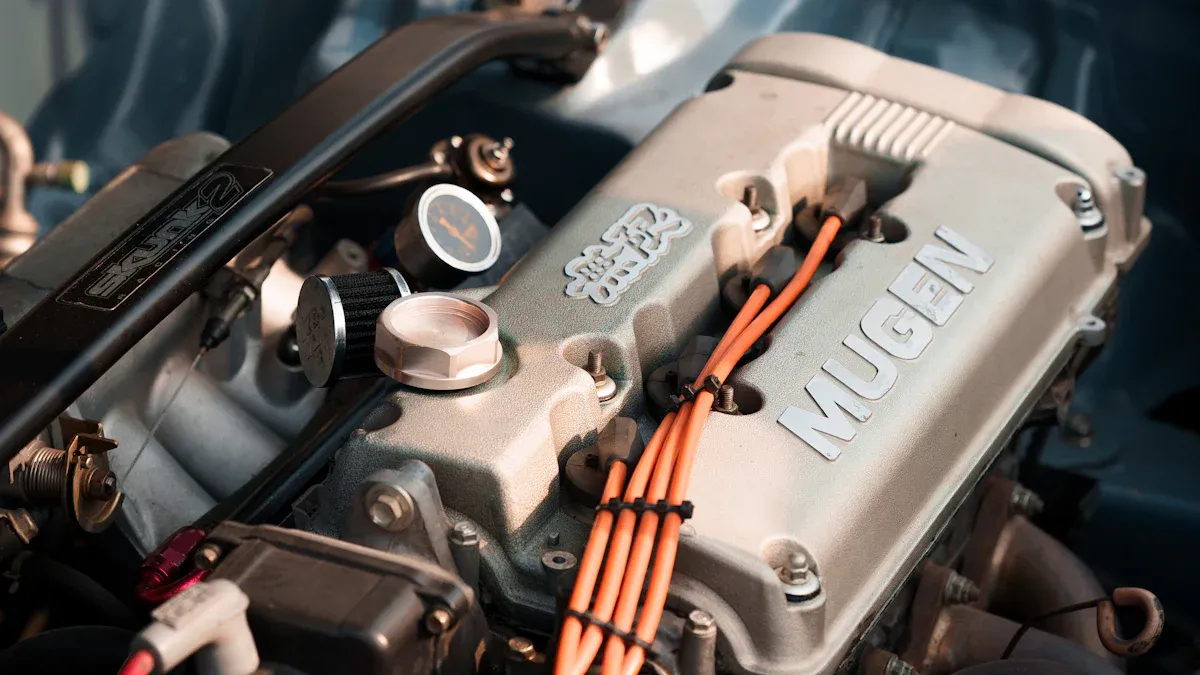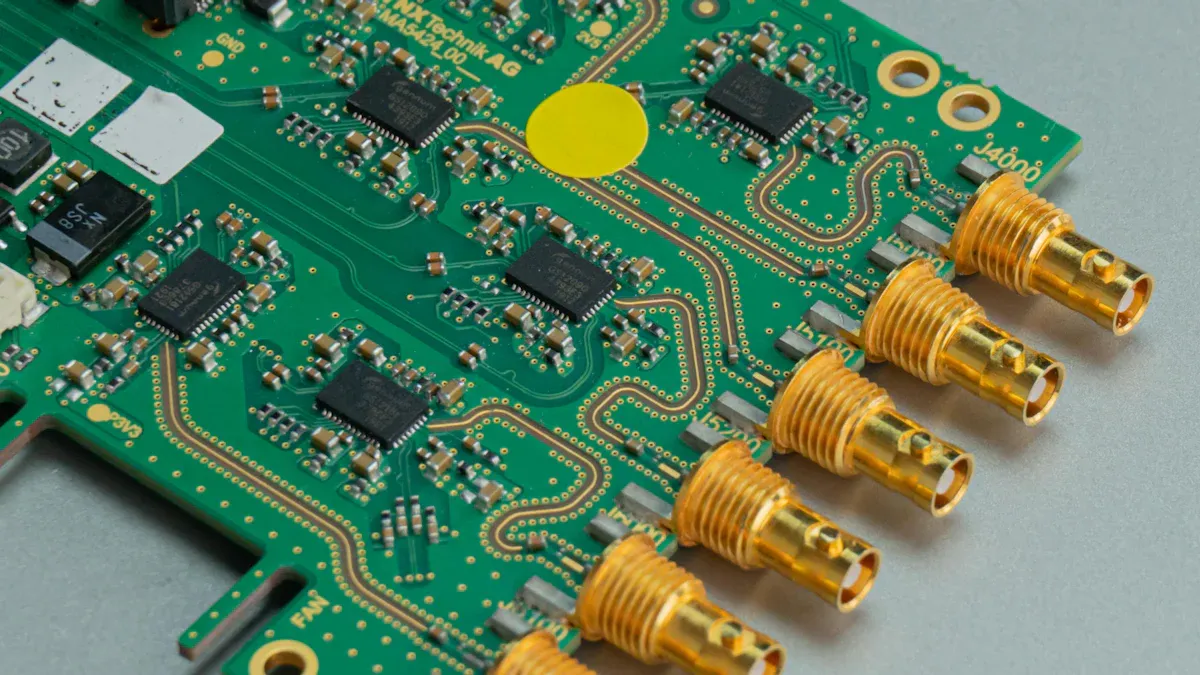
Many people encounter solenoids daily, as they are essential electromechanical devices that move or control various components. The common uses of a solenoid span numerous fields in 2025, including home appliances, factories, automobiles, medical equipment, and security systems. Solenoids play a crucial role in controlling valves, actuators, and switches, making them vital to modern technology. The table below highlights how different industries rely on solenoids for innovation and growth.
| Sector/Application | Market Size (2024) | CAGR (%) Forecast Period | Key Growth Drivers and Notes |
|---|---|---|---|
| U.S. Vacuum Solenoid Valve Market | USD 1.12 billion | 4.5% (2026-2033) | Growth driven by rapid automation in automotive, aerospace, semiconductor sectors |
| Global Vacuum Valve Market | USD 1.64 billion | 8.9% (through 2030) | Broad global demand including industrial and medical applications |
| Pneumatic Solenoid Valves (Automotive & Semiconductor) | USD 0.7 billion | 6.2% (2024-2033) | Increasing integration in automotive systems and semiconductor manufacturing |
| North America Solenoid Valve Market | USD 7.61 billion | N/A | Largest regional market; driven by automotive electrification, advanced manufacturing, and government support |
| Application Segments | N/A | N/A | Automotive, Industrial Machinery, HVAC, Medical Devices, Home Appliances |
| Leading U.S. Cities Growth Rates | N/A | 5.3% to 9.4% CAGR | Cities like New York, San Francisco, Austin, Boston show strong growth in tech, biotech, manufacturing sectors |

Key Takeaways
-
Solenoids help control many things we use every day, like home appliances, cars, and door locks. They make jobs easier and safer for us.
-
In factories, solenoids help machines work by themselves. They also control liquids and help keep people safe with quick and steady actions.
-
Medical devices use solenoids to give medicine in the right amount. They also help these devices work well for patients and doctors.
-
Some solenoids are made to save energy and last a long time. These special solenoids can also be made to fit different needs in many areas.
-
As more machines and smart technology are used, solenoids are needed more. This helps industries work better and use less energy.
Common Uses of a Solenoid
Home Appliances
Solenoids help many home appliances work well. Washing machines use solenoid switches to open and close water valves. This lets the machine control water flow very carefully. Dishwashers use solenoids to drop detergent at the right time. This makes sure every wash works as it should. Refrigerators use solenoid switches to help run the cooling system. This saves energy and keeps food fresh. Gas dryers and stoves use solenoids to turn gas on and off. This makes them safer and more dependable.
Solenoids inside these appliances work fast and last a long time. Putting them inside helps save energy and makes the appliances more trustworthy.
Companies like Burkert make direct-acting solenoid valves for coffee and vending machines. These valves control hot water and steam. This helps drinks taste better and keeps machines working well. SMC Corporation makes stainless steel solenoid valves for drinking water systems. This shows how solenoids can fit special needs.
| Appliance Type | Solenoid Function | Benefit |
|---|---|---|
| Washing Machine | Controls water inlet valve | Precise water management |
| Dishwasher | Releases detergent | Proper cleaning cycles |
| Refrigerator | Regulates cooling system | Energy efficiency |
| Gas Dryer/Stove | Controls gas flow | Safety and reliability |
| Coffee/Vending | Manages hot water/steam | Consistent beverage quality |
Solenoids are now a normal part of home appliances. They give quick action and steady results.
Automotive
The car industry uses solenoids in many ways. Starter solenoids help start engines. They connect the battery to the starter motor. This lets the engine turn on with a key or button. Electric drive systems in new cars also use solenoids. They control power and help change driving modes. Regenerative braking systems use solenoids to switch between braking and saving energy. This helps electric cars save power.
More cars use solenoids every year. The industry is growing fast, with a 4.7% yearly growth rate. This is because people want better fuel use and stronger engines. Solenoids also help control fuel injection and shifting gears. This makes cars safer and work better.
Starter solenoids and electric drive solenoids are very important for new cars. They give steady switching and control. This helps new electric and hybrid cars work well.

Industrial Automation
Factories use solenoids to help machines work by themselves. Solenoids open and close valves for liquids and gases on factory lines. They help run equipment and make sure machines work together. Solenoids are also important for safety shutdown systems. These systems use solenoid shutoff valves that close if power goes out or there is an emergency. This keeps workers and machines safe.
Many solenoid valves are made for safety shutdown jobs. They often work with control valves and positioners. This lets the solenoid take over if there is a safety problem. This means fewer extra safety valves and pipes are needed. It also saves money and makes setup easier.
-
Solenoid valves act fast and work well in safety systems.
-
Electric actuators with backup batteries can move valves to a safe spot if power fails. This lowers the chance of mistakes.
Industrial automation in Texas is growing at 4.6% each year. This is because factories want to be safer and work better. Solenoids help factories follow safety rules and get more done.
| Industry / Sector | Documented Rate / Metric | Notes / Context |
|---|---|---|
| Oil and Gas | 23.6% value share in 2023; CAGR 3.6% (2024-2034) | Leading end-user; valves used for flow control in harsh environments |
| Automotive (Electric Vehicles in California) | Projected CAGR ~4.6% (through 2034) | Driven by innovation and sustainability initiatives; includes electric car infrastructure |
| Industrial Automation (Texas) | CAGR 4.6% (through 2034) | High automation penetration in manufacturing, oil & gas, water treatment sectors |
| Home Appliances | No explicit documented rates; mention of solenoid valves in commercial coffee and vending machines | Example: Burkert's valves for coffee machines and vending machines |
Solenoids are used in factories for automatic control, running equipment, and safety shutdowns. These uses make solenoids very important in today’s factories and plants.
Solenoid Valve Applications

Fluid Control
Solenoid valves help control fluids in many places. In factories and HVAC systems, these valves move liquids and gases very carefully. Companies use solenoid valve technology to save energy and keep things running well. Each solenoid valve has a special coil that uses less power and saves money. These valves work fast, changing water or gas flow in just a few milliseconds. This quick action helps systems work better and use less energy.
-
Solenoid valves give:
-
Long life and need little fixing
-
Safety shutdowns to protect machines
-
Strong parts like brass and stainless steel for hard jobs
-
Real-time checks with smart systems and IoT
-
A solenoid valve can open and close millions of times, so it is great for automatic valve systems. Cleaning and checking them often keeps each solenoid valve working well.
Solenoid valve technology gives exact fluid control, which is important for safety and saving energy.
| Evidence Aspect | Description |
|---|---|
| Industry Experience | Over 77 years of skill and many patents help make good designs. |
| Key Industries | Aerospace, marine, space, military, and factories use solenoid valves to control fluids. |
| Performance Features | Special designs, tight seals, and high trust help in tough jobs. |
Water Treatment
Water treatment plants use solenoid valves to move water and add chemicals. A solenoid water valve opens and closes fast, so water moves just right. This keeps water clean and safe. Solenoid valves also help shut down systems if there are leaks or problems. Stainless steel and nitrile rubber seals help these valves last longer, even in rough water.
Workers use automatic valve systems to watch and change water flow right away. Smart sensors and IoT help workers find and fix problems quickly. This means less downtime and smooth water treatment.
Oil and Gas
The oil and gas industry uses solenoid valves to move gas and liquids in pipes and plants. A solenoid gas valve must be safe in dangerous places. Explosion-proof designs and strong covers stop fires and electric problems. Solenoid valves here often have manual controls and show their position for extra safety.
| Performance Indicator | Description |
|---|---|
| Explosion-proof design | Works safely with high pressure and heat |
| Intrinsically safe circuits | Stops sparks in places that could explode |
| Position feedback systems | Shows valve status right away for safe work |
| Redundancy and diagnostics | Makes sure the system works and finds problems fast |
| Third-party certifications | Meets tough safety and rule standards |
Checking and fixing solenoid valves often keeps them safe. Safety shutdowns and pressure relief help stop accidents. New tools, like smart sensors and AI, help watch and fix problems before they get worse. This makes solenoid valves even safer in oil and gas work.
Medical Devices
Wearable Technology
Wearable medical devices help people check their health each day. Many smartwatches and fitness bands use a solenoid for gentle vibrations. These vibrations remind people about alerts or messages. Some advanced wearables use a solenoid to run tiny pumps. These pumps give medicine or watch blood flow. These devices need small and dependable parts. A solenoid is a good choice because it works for a long time with little care.
Tip: Solenoids in wearables must be light and use little power. This helps batteries last longer.
Drug Delivery
Hospitals and clinics use drug delivery systems with a solenoid. The solenoid controls how much medicine goes out. Insulin pumps use a solenoid valve to give the right amount of insulin. This helps patients stay healthy and safe. Some pain relief devices use a solenoid to control medicine flow. Doctors trust these systems because a solenoid opens and closes fast and right.
| Device Type | Solenoid Role | Benefit |
|---|---|---|
| Insulin Pump | Controls medicine delivery | Accurate dosing |
| Pain Relief Pump | Opens/closes medicine flow | Patient safety |
| Infusion Pump | Regulates fluid movement | Reliable operation |
Diagnostic Equipment
Diagnostic machines like MRI scanners and blood analyzers use a solenoid. The solenoid moves samples or controls valves. It helps guide blood or other fluids through the machine. This makes tests quicker and more correct. Some imaging devices use a solenoid to switch scan modes. Hospitals pick these systems because a solenoid works many times without breaking.
Note: Solenoids in diagnostic equipment help doctors get fast and clear results. This helps patient care.
Access Control
Door Locks
Solenoid technology is important for modern door locks. Many electronic locks use a solenoid to move the bolt fast and safely. These locks usually have set modes like fail-safe or fail-secure. They also need certain voltages to work. This setup is good if you do not need to change the lock settings later. Solenoid locks have fewer moving parts than old-style locks. This makes them more reliable and less likely to break. They work quickly, so they are great for doors that need fast locking. In fail-safe locks, the solenoid uses power to keep the door locked. This can make energy bills go up. Still, these locks are a strong choice where safety and trust matter most.
-
Solenoid locks give:
-
Reliable use with fewer moving parts
-
Fast action for safe entry points
-
Best results when lock needs stay the same
-
Security Systems
Security systems use solenoids for many safety jobs. These devices control barriers, alarms, and emergency exits. Engineers check how well solenoids work by looking at things like failure rates and false alarms. Designers often use two solenoids for one job to make the system safer. Regular checks and care help keep everything safe. Many solenoid systems meet tough safety rules like IEC 61508 and IEC 61511. Some smart solenoids can collect data and test themselves. This helps find problems early and keeps the system working well.
Note: The right solenoid can make a security system safe and dependable, even in hard places.
Vending Machines
Vending machines use solenoid valves to control snacks and drinks. These valves are made from strong materials that can handle cleaning and chemicals. A solenoid in a vending machine can work over three million times before it needs fixing. The small size saves space and lets the machine have more features. Solenoid valves help give the right amount of product every time. This keeps customers happy. Some smart valves can send info about service and use to a main computer. This helps workers keep machines clean, full, and running well.
-
Solenoid valves in vending machines give:
-
Long life and strong parts
-
Exact and repeatable product delivery
-
Easy care and better cleanliness
-
Trends in Solenoid Use
Eco-Friendly Materials
Manufacturers are now making solenoids with eco-friendly materials. Many companies use special alloys that do not rust. They also make smaller parts. These changes help solenoids last longer and work better in hard places. Energy-efficient solenoid valves are becoming more popular each year. This helps people use less energy and save money. New rules for the environment help the market grow every year. More factories pick solenoid valves that follow these rules. About one out of five sales is for water and wastewater management. These products help save water and protect nature.
| Trend/Aspect | Statistic/Detail | Sustainability Impact |
|---|---|---|
| Energy-efficient solenoid valves | Growing at 6% annually | Reduces energy use and costs |
| Market growth from environmental rules | 4% annual growth | Promotes eco-friendly usage |
| Water and wastewater management sales | 20% of total sales | Supports water conservation |
| Advanced materials and miniaturization | Not quantified | Extends product life |
Eco-friendly solenoids help companies reach green goals and lower pollution.
Customization
Many industries want solenoids made just for their needs. Companies now offer different sizes, shapes, and features. Some solenoid valve designs use smart technology like IoT and AI. About 15% of new solenoids have these smart features. Custom solenoids can work in tough places or with special fluids. This helps businesses fix special problems. Engineers can choose the best solenoid for each job. This makes things safer and work better.
-
Custom solenoids may include:
-
Special seals for chemicals
-
Unique shapes for tight spaces
-
Sensors for real-time feedback
-
Automation Growth
Automation is a big reason why solenoids are in demand. Over 40% of the market is for industrial automation. Factories use solenoid valves for fast and careful control. These valves help machines work together and react quickly. Smart technology lets workers find and fix problems before they get worse. More solenoids are used in renewable energy, electric cars, and smart water systems. This shows solenoids are important for the future of automation.
Solenoids and solenoid valves help make automation possible. They save resources and make many industries safer.
Solenoids are used in homes, cars, factories, and hospitals. They help machines move and control how things flow. These devices make life safer and easier for everyone. Companies now use eco-friendly materials to make solenoids. They also design solenoids for special uses. As technology gets better, people will see more smart and energy-saving ideas.
FAQ
What is a solenoid used for in daily life?
People see solenoids in things like washing machines, cars, and door locks. These devices help control water, start car engines, and lock doors. Solenoids make daily jobs easier and keep people safe.
How does a solenoid valve work?
A solenoid valve has an electric coil that moves a plunger. This movement opens or closes the valve. The valve then lets liquids or gases flow or stops them.
Are solenoids safe to use?
Solenoids are safe if you use them the right way. Makers test them to make sure they work well and are safe. Many solenoids have automatic shutoff to stop accidents.
Can solenoids save energy?
Yes! Solenoids save energy by working fast and with care. They only use power when turning on or off. This helps cut down on wasted energy.
Where can someone find solenoids in medical devices?
| Device Type | Example Use |
|---|---|
| Insulin Pump | Controls medicine flow |
| MRI Scanner | Moves parts or samples |
| Blood Analyzer | Directs fluids |
Solenoids help medical devices work safely and do their jobs right.
Written by Jack from AIChipLink.
AIChipLink, one of the fastest-growing global independent electronic components distributors in the world, offers millions of products from thousands of manufacturers, and many of our in-stock parts is available to ship same day.
We mainly source and distribute integrated circuit (IC) products of brands such as Broadcom, Microchip, Texas Instruments, Infineon, NXP, Analog Devices, Qualcomm, Intel, etc., which are widely used in communication & network, telecom, industrial control, new energy and automotive electronics.
Empowered by AI, Linked to the Future. Get started on AIChipLink.com and submit your RFQ online today!













